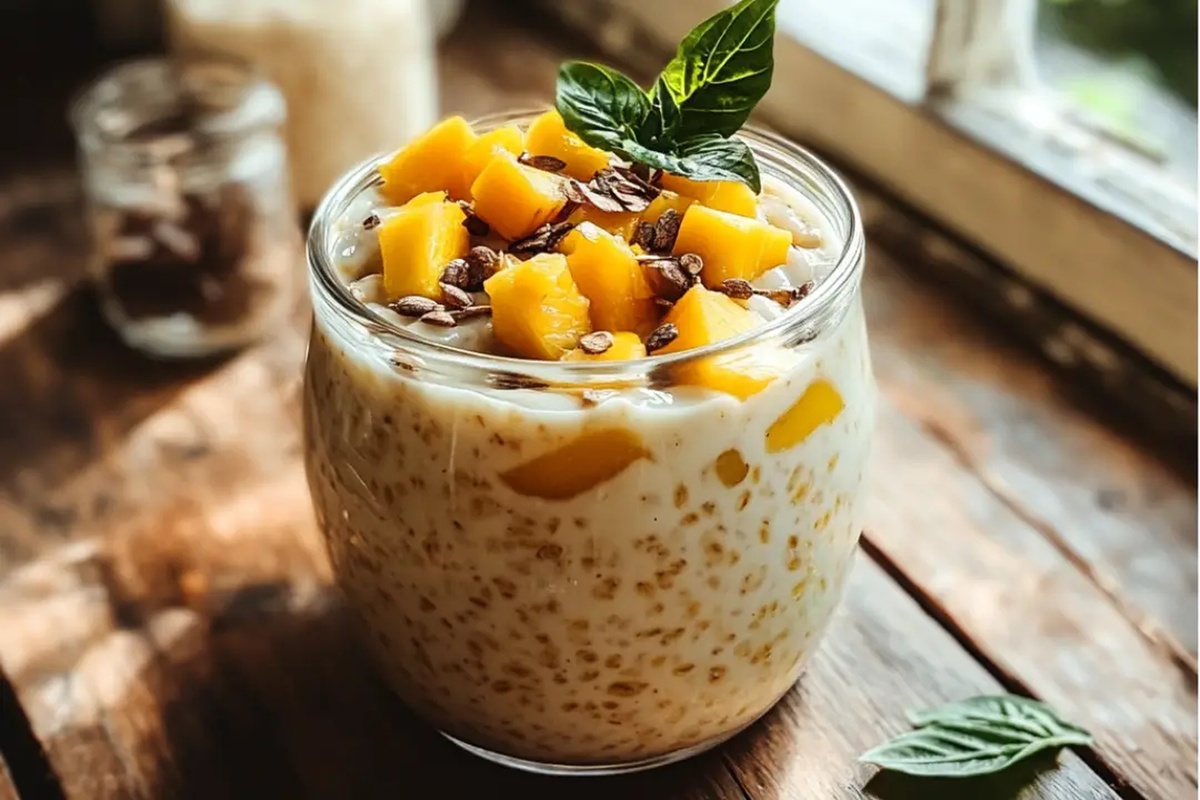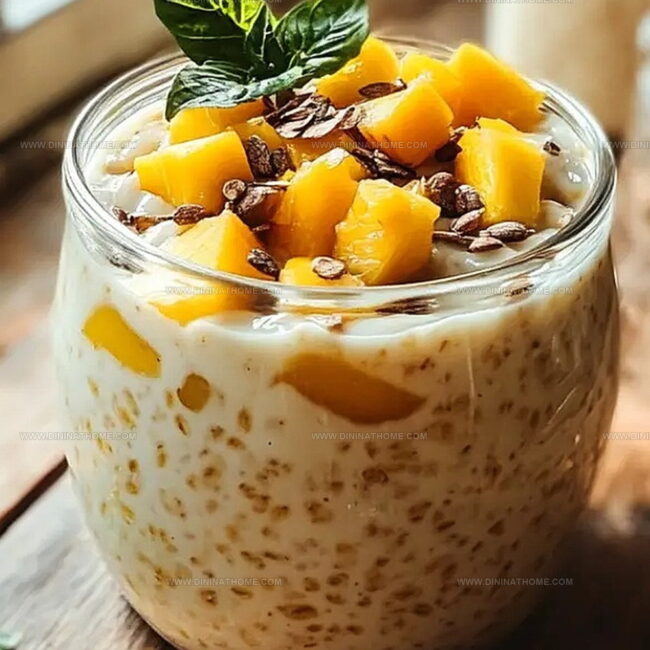Dreamy Mango Lassi Overnight Oats Recipe for Bright Mornings
Cool mornings call for a tropical mango lassi overnight oats twist that’ll make you smile.
Blending creamy yogurt with sweet mango puree creates a breakfast dream.
India’s beloved drink meets hearty oats in this innovative breakfast sensation.
Layers of rich, tangy flavors merge seamlessly in your morning bowl.
Smooth mango notes dance with creamy oats for a refreshing start.
Quick preparation the night before means zero morning stress for you.
Each spoonful promises a delightful escape to sunny landscapes and vibrant flavors.
Wake up to this colorful, nutritious breakfast that celebrates morning magic.
Why Mango Lassi Overnight Oats Will Win You Over
Mango Lassi Overnight Oats – What You’ll Need
Base Ingredients:Fruit Component:Garnish Options:Making Mango Lassi Overnight Oats with Ease
Step 1: Whisk Base Elements
Grab a spacious mixing bowl and toss in rolled oats, creamy yogurt, smooth milk, golden honey, aromatic vanilla extract, and warm ground cardamom.
Blend everything together until the mixture looks completely uniform and silky.
Step 2: Create Mango Smoothness
Using a blender or food processor, transform fresh mango into a velvety, vibrant puree.
Ensure the texture is completely smooth with no chunky bits remaining.
Step 3: Swirl Mango into Oat Mixture
Pour the bright mango puree into the oat base.
Stir gently but thoroughly, creating a beautiful golden-orange color that marbles through the entire mixture.
Step 4: Prepare Overnight Setup
Carefully distribute the luscious mixture into four separate containers or mason jars.
Seal tightly with lids and tuck into the refrigerator.
Let the oats rest and absorb flavors overnight or for a minimum of 6 hours.
Step 5: Final Touch and Presentation
When ready to enjoy, pull out your chilled oats.
Sprinkle fresh chopped mango pieces on top for extra texture.
Optionally, dust with a handful of nutrient-packed chia seeds for added crunch and visual appeal.
Overnight Oats Wisdom: Mango Lassi Edition
Use full-fat Greek yogurt for a richer, more luxurious texture that enhances the overall mango lassi experience.
Stir the mango puree gently to ensure even distribution and prevent liquid from pooling at the bottom of the container.
Adjust honey amount based on the ripeness of your mango – riper fruits mean less added sweetness needed.
Prepare these oats up to 3-4 days in advance for quick, grab-and-go breakfast options throughout the week.
Swap dairy yogurt with coconut or almond yogurt for a vegan-friendly version that maintains the creamy consistency.
Chill Mango Lassi Overnight Oats
What Works with Mango Lassi Overnight Oats
Mango Lassi Overnight Oats Blend Variations
FAQs
Yes, you can use canned mango puree or chunks. Just ensure it’s unsweetened or adjust the honey accordingly to prevent the dish from becoming too sweet.
You can easily make this dairy-free by substituting regular yogurt with coconut or almond yogurt, and using non-dairy milk like almond or oat milk.
These overnight oats can be stored in the refrigerator for up to 3-4 days when kept in airtight containers, making them perfect for meal prep.
While rolled oats are recommended for better texture, quick oats will work. However, they might result in a slightly mushier consistency compared to rolled oats.
Print
Mango Lassi Overnight Oats Recipe
- Total Time: 10 minutes
- Yield: 4 1x
Description
Cool breakfast magic happens when classic Indian flavors meet creamy mango lassi overnight oats. Sweet tropical mango and tangy yogurt blend seamlessly with rolled oats, creating a refreshing morning treat perfect for quick, nourishing starts.
Ingredients
Main Ingredients:
- 2 cups old-fashioned rolled oats
- 2 cups plain yogurt (regular or coconut yogurt)
- 1 cup milk (regular or plant-based)
- 1/2 cup mango, pureed
Sweeteners and Flavors:
- 1/4 cup honey (or maple syrup)
- 1 teaspoon vanilla extract
- 1/2 teaspoon ground cardamom
Optional Toppings:
- 1 teaspoon chia seeds
- Extra mango for garnish
Instructions
- Craft a creamy base by whisking together rolled oats, yogurt, milk, honey, vanilla extract, and ground cardamom in a spacious mixing vessel until thoroughly harmonized.
- Transform fresh mango into a silky, vibrant puree using a blender or immersion blender, ensuring a smooth and consistent texture.
- Gently fold the mango puree into the oat mixture, creating a marbled, golden-hued blend that distributes the fruity essence evenly throughout.
- Allocate the luscious mixture into individual sealed containers, ensuring equal portions that will develop rich flavors during refrigeration.
- Allow the oats to rest and absorb liquid overnight, ideally for 8-10 hours, which will soften the grains and intensify the aromatic profile.
- When ready to enjoy, unveil the chilled oats and embellish with additional diced mango and a sprinkle of chia seeds for textural contrast and nutritional boost.
Notes
- Swap dairy yogurt with coconut or almond yogurt for a vegan-friendly version that maintains creamy texture.
- Adjust honey with maple syrup or agave for alternative sweeteners that complement the mango’s natural sweetness.
- Boost protein content by adding a scoop of vanilla protein powder or Greek yogurt for extra nutrition and thickness.
- Experiment with spice levels by increasing or decreasing cardamom to suit personal taste preferences without overwhelming the mango flavor.
- Prep Time: 10 minutes
- Cook Time: 0 minutes
- Category: Breakfast, Snacks
- Method: Blending
- Cuisine: Indian
Nutrition
- Serving Size: 4
- Calories: 320
- Sugar: 12 g
- Sodium: 100 mg
- Fat: 8 g
- Saturated Fat: 4 g
- Unsaturated Fat: 3 g
- Trans Fat: 0 g
- Carbohydrates: 55 g
- Fiber: 6 g
- Protein: 10 g
- Cholesterol: 20 mg




James Walker
Lead Recipe Developer & Culinary Educator
Expertise
Southern Cuisine & Farm-to-Table Cooking, Recipe Development & Testing, Culinary Education & Instruction
Education
School: Auguste Escoffier School of Culinary Arts
Program: Diploma in Culinary Arts and Operations
Focus: Comprehensive training in classical and modern culinary techniques, kitchen operations, and farm-to-table practices.
James didn’t learn cooking from a TV show, he learned it from busy kitchens, family gatherings, and long afternoons spent testing recipes the hard way.
After training at the Auguste Escoffier School of Culinary Arts, he brought his love for real, down-to-earth food to every dish he makes.
At Dining At Home, James loves building recipes that feel familiar but still have something special, like adding a twist to a classic or making a slow Sunday dinner feel brand new.
When he’s not in the kitchen, you’ll probably find him swapping garden tips at the farmers’ market or teaching his daughter how to flip pancakes without a mess (almost).